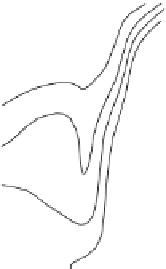Geoscience Reference
In-Depth Information
mmol m
-3
mg m
-3
ºC
0
50
100
10ºW
9ºW
10ºW
9ºW
10ºW
9ºW
Longitude
Figure 10.18
Observations of temperature (left), nitrate (centre) and chlorophyll (right)
along a transect line (white line in Fig.
10.17a
) perpendicular to the Portuguese coast,
collected during July 1994. Adapted from Ballestero and Boxall (
1997
), courtesy of
ESA/Earthnet Online.
(Ballestero and Boxall,
1997
) which illustrates how the cool, nitrate-rich water is
raised towards the sea surface in upwelling over the very narrow shelf, and produces
an increase in surface and sub-surface chlorophyll at the coast.
We need to remember that upwelled water, while high in nitrate, will initially have
a low phytoplankton concentration; it brings with it a seed stock of phytoplankton
that will utilise the nitrate and grow as the water begins to experience the higher light
levels at the sea surface. The availability of light for phytoplankton growth will
depend on how stratification develops in the upwelled water once it starts to respond
to the near-surface heating. The combination of the developing physical structure
and the nutrient assimilation and growth rates of the phytoplankton will lead to
some delay between the initial wind event and the subsequent response of the
different species within the seed phytoplankton community. This delay in biogeo-
chemical response has been observed in the Peruvian upwelling system by carrying
out experiments on the phytoplankton nutrient uptake rates next to a series of
drogued buoys that were used to track recently upwelled parcels of water (MacIsaac
et al.,
1985
). Note in
Fig. 10.19
that there is a delay of
∼
2 days in the uptake of
nitrate, with the maximum nitrate uptake occurring about 5 days after the upwelling
event brings the phytoplankton and nitrate-laden water up into the euphotic zone.
Chlorophyll was also seen to peak, but later again than the maximum in nitrate
uptake; chlorophyll later decreased as the phytoplankton became nutrient limited.
The whole sequence from arrival of upwelled water at the sea surface to depletion of
nitrate and the reduction of biomass took 8-10 days, and was limited to a narrow
region of 30-60 km from the coast. The phytoplankton population during the
tracked upwelling event was dominated by diatoms. This is a common observation
in upwelling regions (e.g. off the Iberian Peninsula (Huete-Ortega et al.,
2010
),
during monsoon-driven upwelling in the Arabian Sea (Barber et al.,
2001
), in the










































Search WWH ::

Custom Search